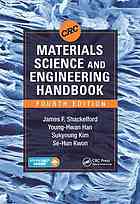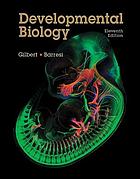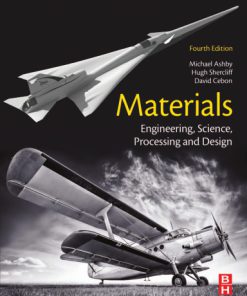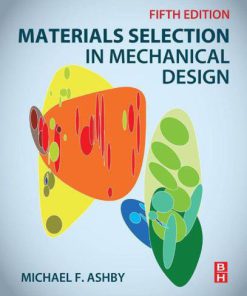Engineering Materials 1 5th by David R.H. Jones And Michael F. Ashby 008102052X 9780081020517
$50.00 Original price was: $50.00.$25.00Current price is: $25.00.
Engineering Materials 1 5th by David R.H. Jones And Michael F. Ashby – Ebook Instant Download/Delivery ISBN: 008102052X ,9780081020517
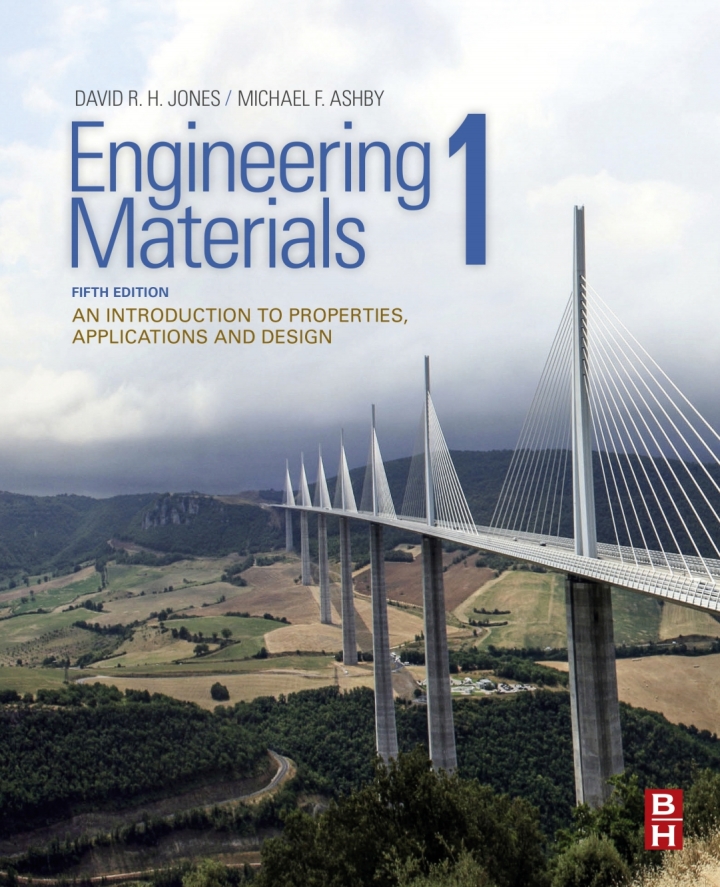
Product details:
Widely adopted around the world, Engineering Materials 1 is a core materials science and engineering text for third- and fourth-year undergraduate students; it provides a broad introduction to the mechanical and environmental properties of materials used in a wide range of engineering applications. The text is deliberately concise, with each chapter designed to cover the content of one lecture. As in previous editions, chapters are arranged in groups dealing with particular classes of properties, each group covering property definitions, measurement, underlying principles, and materials selection techniques. Every group concludes with a chapter of case studies that demonstrate practical engineering problems involving materials. The 5th edition boasts expanded properties coverage, new case studies, more exercises and examples, and all-around improved pedagogy.
Engineering Materials 1, Fifth Edition is perfect as a stand-alone text for a one-semester course in engineering materials or a first text with its companion Engineering Materials 2: An Introduction to Microstructures and Processing, in a two-semester course or sequence.
- New chapters on magnetic, optical, thermal and electrical properties, with appropriate case studies of applications
- Improved pedagogy, featuring more relevant photographs, new glossary of terms, additional worked examples, plus 50% more exercises than in previous edition, now graded according to difficulty
- Improved discussion of supply and demand in Chapter 2
- Discussion at various points throughout the book of how nanomaterials can differ from larger-scale materials in their properties
- New case studies on medical materials/biomaterials
Table of contents:
Chapter 1: Engineering Materials and Their Properties
1.1. Introduction
1.2. Examples of Materials Selection
Part A: Price and Availability
Chapter 2: Price and Availability of Materials
Contents
2.1. Introduction
2.2. Data for material prices
2.3. Use-pattern of materials
2.4. Ubiquitous materials
Composition of the earth’s crust
2.5. Exponential Growth and Doubling-Time
2.6. Resource availability
2.7. The future
Material-efficient design
Substitution
Recycling
2.8. Conclusion
Environmental impact
Worked Example
Examples
Answers
Part B: Elastic Moduli
Chapter 3: Elastic Moduli
contents
3.1. Introduction
3.2. Definition of Stress
Ways of writing stress (SI metric system)
Common states of stress
3.3. Definition of Strain
3.4. Hooke’s Law
3.5. Measurement of Young’s Modulus
3.6. Data for Young’s Modulus
Worked Example 1
Worked Example 2
Examples
Answers
Chapter 4: Bonding between Atoms
Contents
4.1. Introduction
4.2. Primary Bonds
4.3. Secondary Bonds
4.4. Condensed states of matter
4.5. Interatomic Forces
Examples
Answers
Chapter 5: Packing of Atoms in Solids
Contents
5.1. Introduction
5.2. Atom Packing in Crystals
5.3. Close-Packed Structures and Crystal Energies
5.4. Crystallography
5.5. Plane Indices
5.6. Direction Indices
Worked Example 1
5.7. Other Crystal Structures
Worked Example 2
5.8. Atom Packing in Polymers
5.9. Atom Packing in Inorganic Glasses
5.10. Density of Solids
Examples
Answers
Chapter 6: Physical Basis of Young’s Modulus
contents
6.1. Introduction
6.2. Moduli of Crystals
6.3. Rubbers and Glass Transition Temperature
6.4. Composites
Worked Example
Examples
Answers
Chapter 7: Applications of Elastic Deformation
Contents
7.1. Introduction
7.2. Bending
Worked Example 1
7.3. Vibration
Worked Example 2
7.4. Buckling
Worked Example 3
7.5. Stress and Strain in Three Dimensions
Examples
Answers
Bending of Beams
Second Moments of Area
Vibration of Beams
Buckling of Beams
Chapter 8: Case Studies in Modulus-Limited Design
contents
8.1. Case Study 1: Selecting Materials for Racing Yacht Masts
8.2. Case Study 2: Designing a Mirror for a Large Reflecting Telescope
8.3. Case Study 3: The Challenger Space Shuttle Disaster
Postscript
Worked example
Examples
Answers
Part C: Yield Strength, Tensile Strength, and Ductility
Chapter 9: Yield Strength, Tensile Strength, and Ductility
contents
9.1. Introduction
9.2. Linear and Nonlinear Elasticity
9.3. Load-Extension Curves for Nonelastic (Plastic) Behavior
9.4. True Stress-Strain Curves for Plastic Flow
9.5. Plastic Work
9.6. Tensile Testing
9.7. Data
Worked Example
Examples
Answers
Revision of Terms and Useful Relations
Chapter 10: Dislocations and Yielding in Crystals
Contents
10.1. Introduction
10.2. Strength of a Perfect Crystal
10.3. Dislocations in Crystals
10.4. Force Acting on a Dislocation
10.5. Other Properties of Dislocations
Examples
Answers
Chapter 11: Strengthening and Plasticity of Polycrystals
Contents
11.1. Introduction
11.2. Strengthening Mechanisms
11.3. Solid Solution Hardening
11.4. Precipitate and Dispersion Strengthening
11.5. Work-Hardening
11.6. Dislocation Yield Strength
11.7. Yield in Polycrystals
Grain-boundary strengthening (Hall-Petch effect)
11.8. Final Remarks
Examples
Answers
Chapter 12: Continuum Aspects of Plastic Flow
Contents
12.1. Introduction
12.2. Onset of yielding and shear yield strength, k
12.3. Analyzing the hardness test
12.4. Plastic instability: necking in tensile loading
Consequences of plastic instability
Worked example
Examples
Answers
Plastic bending of beams, torsion of shafts, buckling of struts
Bending of beams
Plastic moments
Shearing torques
Plastic buckling
Chapter 13: Case Studies in Yield-Limited Design
Contents
13.1. Introduction
13.2. Case Study 1: Elastic Design-Materials for Springs
The leaf spring
Worked Example
Mechanics
Metallic materials for the clutch springs
Nonmetallic materials
13.3. Case Study 2: Plastic Design-Materials for Pressure Vessels
13.4. Case Study 3: Large-Strain Plasticity-Metal Rolling
Examples
Answers
Part D: Fast Fracture, Brittle Fracture, and Toughness
Chapter 14: Fast Fracture and Toughness
Contents
14.1. Introduction
14.2. Energy Criterion for Fast Fracture
Worked example
Fast fracture at fixed displacements
Fast fracture at fixed loads
Fast-fracture condition
14.3. Data for Gc and Kc
Note on the stress intensity factor, K
Examples
Answers
Y Values
K Conversions
Chapter 15: Micromechanisms of Fast Fracture
Contents
15.1. Introduction
15.2. Mechanisms of Crack Propagation 1: Ductile Tearing
15.3. Mechanisms of Crack Propagation 2: Cleavage
15.4. Composites, Including Wood
15.5. Avoiding Brittle Alloys
Worked Example
Examples
Answers
Chapter 16: Fracture Probability of Brittle Materials
Contents
16.1. Introduction
16.2. Statistics of Strength
16.3. Weibull Distribution
Worked Example 1
Worked Example 2
16.4. Modulus of Rupture
Worked Example 3
Worked Example 4
Examples
Answers
Chapter 17: Case Studies in Fracture
Contents
17.1. Introduction
17.2. Case Study 1: Fast Fracture of an Ammonia Tank
Details of the failure
Material properties
Calculation of critical stress for fast fracture
Conclusions
17.3. Case Study 2: Explosion of a Perspex Pressure Window during Hydrostatic Testing
Design data
Failure analysis
Conclusions
17.4. Case Study 3: Cracking of a Foam Jacket on a Liquid Methane Tank
Thermal stresses in the foam
Conclusions
Worked Example
Examples
Answers
Part E: Fatigue Failure
Chapter 18: Fatigue Failure
Contents
18.1. Introduction
18.2. Fatigue of Uncracked Components
18.3. Fatigue of Cracked Components
18.4. Fatigue Mechanisms
Worked Example 1
Worked example 2
Examples
Answers
Chapter 19: Fatigue Design
Contents
19.1. Introduction
19.2. Fatigue Data for Uncracked Components
19.3. Stress Concentrations
19.4. Notch Sensitivity Factor
19.5. Fatigue Data for Welded Joints
19.6. Fatigue Improvement Techniques
19.7. Designing Out Fatigue Cycles
Worked Example
Examples
Answers
Chapter 20: Case Studies in Fatigue Failure
Contents
20.1. Case Study 1: The Comet Air Disasters
20.2. Case Study 2: The Eschede Railway Disaster
20.3. Case Study 3: Safety of the Stretham Engine
Mechanics
Failure by fast fracture
Failure by fatigue
Examples
Answers
Part F: Creep Deformation and Fracture
Chapter 21: Creep and Creep Fracture
contents
21.1. Introduction
21.2. Creep Testing and Creep Curves
21.3. Creep Relaxation
21.4. Creep Damage and Creep Fracture
21.5. Creep-Resistant Materials
Worked Example
Examples
Answers
Chapter 22: Kinetic Theory of Diffusion
contents
22.1. Introduction
22.2. Diffusion and Fick’s Law
22.3. Data for Diffusion Coefficients
22.4. Mechanisms of Diffusion
Bulk diffusion: Interstitial and vacancy diffusion
Fast diffusion paths: Grain boundary and dislocation core diffusion
A useful approximation
Worked example
Examples
Answers
Chapter 23: Mechanisms of Creep, and Creep-Resistant Materials
Contents
23.1. Introduction
23.2. Creep Mechanisms: Metals and Ceramics
Dislocation creep (giving power-law creep)
Diffusion creep (giving linear-viscous creep)
Deformation mechanism diagrams
Creep fracture
Designing metals and ceramics to resist power-law creep
Designing metals and ceramics to resist diffusional flow
23.3. Creep Mechanisms: Polymers
Designing polymers to resist creep
23.4. Selecting Materials to Resist Creep
Worked Example
Examples
Answers
Chapter 24: The Turbine Blade-A Case Study in Creep-Limited Design
Contents
24.1. Introduction
24.2. Properties Required of a Turbine Blade
24.3. Nickel-Based Super-Alloys
24.4. Engineering Developments-Blade Cooling
24.5. Future Developments: High-Temperature Ceramics
24.6. Cost Effectiveness
Worked Example
Examples
Answers
Part G: Oxidation and Corrosion
Chapter 25: Oxidation of Materials
contents
25.1. Introduction
25.2. Energy of Oxidation
25.3. Rates of Oxidation
25.4. Data
25.5. Micromechanisms
Examples
Answers
Chapter 26: Case Studies in Dry Oxidation
Contents
26.1. Introduction
26.2. Case Study 1: Making Stainless Alloys
26.3. Case Study 2: Protecting Turbine Blades
Influence of coatings on mechanical properties
Protecting future blade materials
26.4. Case study 3: Joining Metals by Soldering and Brazing
Examples
Answers
Chapter 27: Wet Corrosion of Materials
Contents
27.1. Introduction
27.2. Wet Corrosion
27.3. Voltage Differences as the Driving Force for Wet Oxidation
27.4. Pourbaix (Electrochemical Equilibrium) Diagrams
27.5. Some Examples
Copper
Steel
Aluminum
27.6. Standard Electrode Potentials
27.7. Localized Attack
Examples
Answers
Rates of Uniform Metal Loss
Chapter 28: Case Studies in Wet Corrosion
contents
28.1. Case Study 1: Protecting Ships’ Hulls from Corrosion
28.2. Case Study 2: Rusting of a Stainless Steel Water Filter
28.3. Case Study 3: Corrosion in Reinforced Concrete
28.4. Small Anodes and Large Cathodes
Worked Example 1
Worked Example 2
Examples
Answers
Part H: Friction and Wear
Chapter 29: Friction and Wear
Contents
29.1. Introduction
29.2. Friction between Materials
29.3. Coefficients of Friction
29.4. Lubrication
29.5. Wear of Materials
Adhesive wear
Abrasive wear
29.6. Surface and Bulk Properties
Worked Example
Examples
Answers
Chapter 30: Case Studies in Friction and Wear
Contents
30.1. Introduction
30.2. Case Study 1: Design of Journal Bearings
Embeddability
Conformability
Preventing seizure
30.3. Case Study 2: Materials for Skis and Sledge Runners
30.4. Case Study 3: High-Friction Rubber
Examples
Answers
Part I: Thermal Properties
Chapter 31: Thermal Expansion
Contents
31.1. Introduction
Worked Example 1
31.2. Coefficients of Thermal Expansion
31.3. Physical Basis of Thermal Expansion
Worked Example 2
31.4. Thermal Expansion of Composites
31.5. Case Studies
Temperature switches
Continuous welded railroad track
Glass-to-metal seals
Examples
Answers
Chapter 32: Thermal Conductivity and Specific Heat
Contents
32.1. Introduction
Worked Example 1
32.2. Thermal Conductivities and Specific Heats
32.3. Physical Basis of Specific Heat
32.4. Physical Basis of Thermal Conductivity
Worked Example 2
Worked Example 3
Worked Example 4
32.5. Case Studies
Distortion and cracking of a heat exchanger
Getting rid of frictional heat
Seats that feel “warm´´ and seats that feel “cold´´
Worked Example 5
Examples
Answers
Chapter 33: Final Case Study:: Materials and Energy in Car Design
Contents
33.1. Introduction
33.2. Energy and Carbon Emissions
33.3. Achieving Energy Economy
33.4. Material Content of a Car
33.5. Alternative Materials
Primary mechanical properties
Secondary properties
33.6. Production Methods
33.7. Conclusions
Appendix: Symbols and Formulae
Principal Symbols
Other Symbols
Principal Formulae
Chapter 2
Chapter 3
Chapter 6
Chapter 7
Chapter 9
Chapters 10 and 11
Chapter 12
Chapters 14 and 15
Chapter 16
Chapters 18 and 19
Chapter 21
Chapter 22
Chapter 23
Chapter 25
Chapter 27
Chapter 29
Chapter 31
Chapter 32
People also search:
engineering materials solutions
engineering materials quizlet
materials engineering handbook pdf
k5 1st grade math
materials engineering textbook pdf
You may also like…
Business & Economics
Better Business 5th Edition by Michael Solomon, Kendall Martin ISBN 9780136879749 0136879748
Biology and other natural sciences
Chemistry - Organic Chemistry
Biology and other natural sciences - Biology
Engineering






